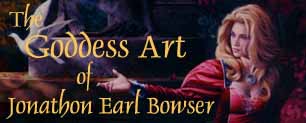Graeco-Roman Goddesses
| Bellona, Lady of War |
Cardea, Lady Protectress |
Carmentis, Mistress of Prophecy |
| Ceres, Lady of Grain |
Diana, Lady of Wild Things |
Erinyes, Vengeful Ones |
| Flora, Lady of Flowers |
Hekate, Mistress of Magic |
Juno, Queen of Heaven |
| Kore, Stolen Spring |
Minerva, Lady of Handicrafts |
Nymphae, Spirits of Nature |
| Pomona, Lady Orchard |
Venus, Mistress of Pleasure |
Vesta, Hearth Fire |
Along with Judeo-Christianity, ancient Greece is considered
by many to be the ideological parent of modern Western culture: it was from
the Greeks that we inherited logic, reasoning, dialectics, philosophy, and
much of mathematics and science. Yet Greece was more than the Golden Age
of Pericles, more than the rational, aesthetic Parthenon. Greece was a land
of ancient conflicts, tribal prejudices and feuds, masculine might and
exploration and war and trade, feminine oppression and domesticity and frenzied
spirituality.
Thousands of years before the Age of Pericles, Greece was a
land of mother-right. Goddesses and a few Gods were worshipped by an agrarian,
sedentary people knowledgeable in smithcraft. The culture seems to have been
largely peaceful, matrifocal and perhaps egalitarian. Then, the invasions
began. They came in series, one after another, four in all. They began about
four thousand years before the common era, with invaders descending from
the north; they may have migrated from the Russian Steppes. The first few
invasions were incomplete; the conquered peoples absorbed their conquerers
and life went on. It was the final invasion, though, in about 1800 BCE, which
brought an end to matrifocal Greece. The Dorians were true barbarians, skilled
in the advanced use of bronze and chariots, but illiterate and patriarchal;
they worshipped sky and war Gods, and may have brought with them an antecedent
of Athena. With their conquest, writing was lost. All evidence of the life
and ways of this time comes from archaeological excavations and supposition;
the Trojan War was fought and the ILIAD and perhaps the ODYSSEY were orally
composed during this time. It was hundreds of years before the Greeks clawed
their way out of their Dark Ages. Writing was rediscovered; true marine
exploration began; trade expanded; colonies were established in Asia Minor,
the Italian and Iberian Peninsulas, and northern Africa. By then, the war
between the Gods and the Goddesses had waged for centuries, and would go
on for centuries more.
The myths tell us of this war: of the first patriarchal invasions,
the rapes of native Goddesses by invading Gods; the division of the Goddess
from whole Earth Mother into autonomous entities with distinct responsibilities;
the ascension of male over female; the loss of women's status; new codes
of conduct for women, in which virtuous women support husbands and fathers
over mothers and brothers and sisters. The Titans overthrow the Primal Mother
and Her Consort, and are in turn overthrown by the Olympians; Zeus rapes
Hera and forces Her into marriage; Artemis becomes the chaste Goddess of
the Hunt, lossing Her identity as fertile Earth Mother; heroes slay great
female monsters, such as Medusa; the women of Athens are forced to give up
the vote, their maternal family names, and their children; Antigone is condemned
to death for supporting her brother--the man who shared her mother's womb--over
her uncle.The conflict is a dynamic, fiery battle which yet goes on.
Psychoanalysts have discovered in all mythologies--but most
clearly in the Greek--the archetypes of the human psyche. Archetypes are
primal images, recognized by all peoples, which produce universal reactions
and carry universal meaning. The recognition and reaction are more often
subconscious, though, than conscious. The cup and bowl are symbolic of the
womb, belly, fertility, et cetera. The snake which sheds its skin is eternity,
immortality, rebirth, sexuality. Demeter is the Mother, nurturance, kindness,
security, fertility. Artemis is the Maiden, complete in Herself, autonomous,
fierce, determined, courageous. Apollo is Order, logic, light, rationality,
suppression of emotion. Dionysus is Disorder, illogic, irrationality, exuberance
of emotion.
These Gods and Goddesses developed over centuries as the ways
and psyches and tales of the invaders and the invaded fought, merged and
compromised. The Greeks considered their Deities to be universal, and so,
as trade and conquest and colonization expanded their knowledge of the world,
they equated their Deities with those of other peoples. Horus became the
Egyptian form of Apollo, Anahita the Persian name for Artemis, Cybele the
Anatolian form of Rhea, and so on. The Romans-- conquerors and inheritors
of Grecian civilization--continued this trend: native Latin Deities were
equated with Grecian Deities of similar attributes; in many cases, though
not all, the Grecian form and mythology superceded the Latin, and the native
mythology was lost. Not all equations were exact, whoever, and some Deities
appear positively schizophrenic. For others, no Greek Deity could be found,
and so the native Latin God or Goddess survived: Iuturna, for instance, a
native Goddess of Youth and Water.
Since the Roman names are generally more familiar than the
Greek, I have chosen to list the Goddesses in their Latin form. However,
Greek names, where possible, are included in the tales.
As usual, any criticism or suggestion is welcome, so please
mail me.
Back to Introduction
Back to Graeco-Roman Goddesses
Back to Goddesses
To Himalayan Goddesses
Bellona, Lady of War
| Bellona is an ancient, native Roman Goddess often associated with Mars.
In later years, She was assimilated to Mah of Asia Minor. Her faith was described
as bloody and orgiastic. |
Back to Graeco-Roman Goddesses
Cardea, Lady Protectress
| Though ridiculed as the Goddess of Door Hinges, Cardea was in fact an
important Deity of the Roman family. She is often in company with Janus,
the two-faced God of Thresholds and Beginnings and Endings. |
Back to Graeco-Roman Goddesses
Carmentis, Mistress of Prophecy
| Though not counted among the traditional Twelve Olympians, Carmentis
was an extremely important Roman Goddess. She was also known as Carmenta
and Nicostrata. She was often in company with various Goddesses of Birth
and Children, and with Apollo. |
Back to Graeco-Roman Goddesses
Ceres, Lady of Grain
| The native Roman Goddess Ceres was assimilated with the Greek Goddess
Demeter. The story of Demeter and Persephone is well-known. In Rome, Persephone
was known as Proserpina. |
Back to Graeco-Roman Goddesses
Diana, Lady of Wild Things


|
Diana, a native Roman Goddess worshipped especially at Lake
Nemi, was easily assimilated with the Graeco-Asian Goddess, Artemis. In
archetypal psychology, Artemis/Diana has come to represent the multifaceted,
contradictory, beautiful, violent aspects of the feminine psyche. Her temple
at Ephesus was one of the Wonders of the Ancient World and the site of one
of Saint Paul's least-successful missions. The image is an oil painting of
THE GODDESS OF THE VALE by Jonathon Earl Bowser. |
Back to Graeco-Roman Goddesses
Erinyes, Vengeful Ones
| Also known as Eumenides, "Beautiful Ones," these Greek Goddesses were
adopted by the Romans, who called them Furiae. More ancient then the Olympian
pantheon, the triune Erinyes once served the Great Goddess, punishing those
who broke Her laws. |
Back to Graeco-Roman Goddesses
Flora, Lady of Flowers
| Though not counted among the Olympian Twelve, Flora was a Goddess much
loved by the Roman people. Her festivals were popular occasions. The reason
for Her popularity and importance eluded historians and mythologists who
failed to recognize the connection between flowers, sex and reproduction. |
Back to Graeco-Roman Goddesses
Hekate, Mistress of Magic
| Hekate is a Goddess much misunderstood--not only by cotemporary historians,
but also by classical authorities. Views of Hekate, a native Goddess of Asia
Minor adopted by Greeks and Romans, varied from demonic witch to benevolent
teacher of the Mysteries. She is a Goddess popular with modern-day Pagans. |
Back to Graeco-Roman Goddesses
Juno, Queen of Heaven
| Though generally equated with the Greek Goddess Hera, Juno was in fact
a native Latin Goddess with a mythology of Her own; some has survived. Her
disposition was also much different than Hera's, and She was accounted the
wisest counselor and beloved wife of Jupiter. |
Back to Graeco-Roman Goddesses
Kore, Stolen Spring
 |
This Maiden Goddess is one of the protagonists in an ancient seasonal
myth; unlike many other such myths, the Deity Who descended to the underworld
was not the beloved son/lover, but the beloved daughter/self. See also Ceres
and Hekate, profiled above. |
PERSEPHONE AND DEMETER from ART AND
WORDS ©Kris Waldherr
Back to Graeco-Roman Goddesses
Minerva, Lady of Handicrafts
| Under Her Greek name of Athena, She was the powerful Matron Goddess of
Athens. As Minerva, She was one part of the great Capitoline Triad, the three
Great Ones of Rome. |
Back to Graeco-Roman Goddesses
Nymphae, Spirits of Nature
| Many ancient peoples, and even many today, believe every aspect of nature
possesses its own spirit. The Greeks and Romans called these spirits Nymphs,
and often depicted them in human, female form. Nymphs varied in temperament
and importance (to humans); many myths record Their affairs or marriages
to Gods and mortals, and their semi-Divine offspring. See Sago Woman (Descent
of the Gods chapter), Askefruer (Northern European Goddesses), Yakshi (Hindu
Goddesses) and Pomona (below). |
Back to Graeco-Roman Goddesses
Pomona, Lady Orchard
| Though a Goddess important to the Romans, little of Her mythology survived,
even into the time of the Empire (first century CE). The one well-known myth
is believed by modern historians to have been invented at a late date. Goddesses
of fruit trees were common throughout the ancient world, as They still are
today. See also Idun (Northern European section), Honored High Mistress (Creation
chapter), and Sago Woman (Descent of the Gods chapter). |
Back to Graeco-Roman Goddesses
Venus, Mistress of Pleasure

 |
Many modern people consider Venus to be nothing more than
a Goddess of Sex; in fact, sex was only one of Her many responsibilities.
Venus (Greek name, Aphrodite), was concerned with all aspects of Love, Pleasure,
Beauty and Procreation. There are a few discrepancies between Her Greek and
Roman myths, as related below. |
Back to Graeco-Roman Goddesses
Vesta, Hearth Fire
| Only two myths are known of Vesta, both under Her Greek name of Hestia,
and each of these appears to be a recording of the patriarchal invasions.
Vesta was an ancient Deity of Hearth and Home. Her sacred fire was the central
sacred site of Rome; it was prophesied that when Her fire was extinguished,
Rome would fall. It did. |
Back to Graeco-Roman Goddesses
Back to Introduction
Back to Egyptian Goddesses
Back to Goddesses
To Himalayan Goddesses




